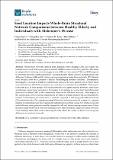| dc.contributor.author | Zajac, Lauren | en_US |
| dc.contributor.author | Koo, Bang-Bon | en_US |
| dc.contributor.author | Bauer, Corinna M. | en_US |
| dc.contributor.author | Killiany, Ron | en_US |
| dc.date.accessioned | 2017-05-01T19:27:25Z | |
| dc.date.issued | 2017 | en_US |
| dc.identifier.citation | Zajac, Lauren, Bang-Bon Koo, Corinna M. Bauer, and Ron Killiany. 2017. “Seed Location Impacts Whole-Brain Structural Network Comparisons between Healthy Elderly and Individuals with Alzheimer’s Disease.” Brain Sciences 7 (4): 37. doi:10.3390/brainsci7040037. http://dx.doi.org/10.3390/brainsci7040037. | en |
| dc.identifier.issn | | en |
| dc.identifier.uri | http://nrs.harvard.edu/urn-3:HUL.InstRepos:32630570 | |
| dc.description.abstract | Whole-brain networks derived from diffusion tensor imaging (DTI) data require the identification of seed and target regions of interest (ROIs) to assess connectivity patterns. This study investigated how initiating tracts from gray matter (GM) or white matter (WM) seed ROIs impacts (1) structural networks constructed from DTI data from healthy elderly (control) and individuals with Alzheimer’s disease (AD) and (2) between-group comparisons using these networks. DTI datasets were obtained from the Alzheimer’s disease Neuroimaging Initiative database. Deterministic tractography was used to build two whole-brain networks for each subject; one in which tracts were initiated from WM ROIs and another in which they were initiated from GM ROIs. With respect to the first goal, in both groups, WM-seeded networks had approximately 400 more connections and stronger connections (as measured by number of streamlines per connection) than GM-seeded networks, but shared 94% of the connections found in the GM-seed networks. With respect to the second goal, between-group comparisons revealed a stronger subnetwork (as measured by number of streamlines per connection) in controls compared to AD using both WM-seeded and GM-seeded networks. The comparison using WM-seeded networks produced a larger (i.e., a greater number of connections) and more significant subnetwork in controls versus AD. Global, local, and nodal efficiency were greater in controls compared to AD, and between-group comparisons of these measures using WM-seeded networks had larger effect sizes than those using GM-seeded networks. These findings affirm that seed location significantly affects the ability to detect between-group differences in structural networks. | en |
| dc.language.iso | en_US | en |
| dc.publisher | MDPI | en |
| dc.relation.isversionof | doi:10.3390/brainsci7040037 | en |
| dc.relation.hasversion | http://www.ncbi.nlm.nih.gov/pmc/articles/PMC5406694/pdf/ | en |
| dash.license | LAA | en_US |
| dc.subject | DTI | en |
| dc.subject | Alzheimer’s disease | en |
| dc.subject | graph theory | en |
| dc.subject | structural networks | en |
| dc.subject | MRI | en |
| dc.subject | diffusion | en |
| dc.title | Seed Location Impacts Whole-Brain Structural Network Comparisons between Healthy Elderly and Individuals with Alzheimer’s Disease | en |
| dc.type | Journal Article | en_US |
| dc.description.version | Version of Record | en |
| dc.relation.journal | Brain Sciences | en |
| dash.depositing.author | Bauer, Corinna M. | en_US |
| dc.date.available | 2017-05-01T19:27:25Z | |
| dc.identifier.doi | 10.3390/brainsci7040037 | * |
| dash.contributor.affiliated | Bauer, Corinna | |


